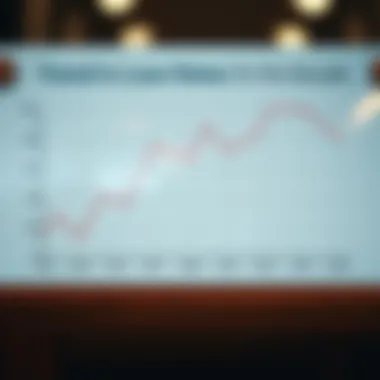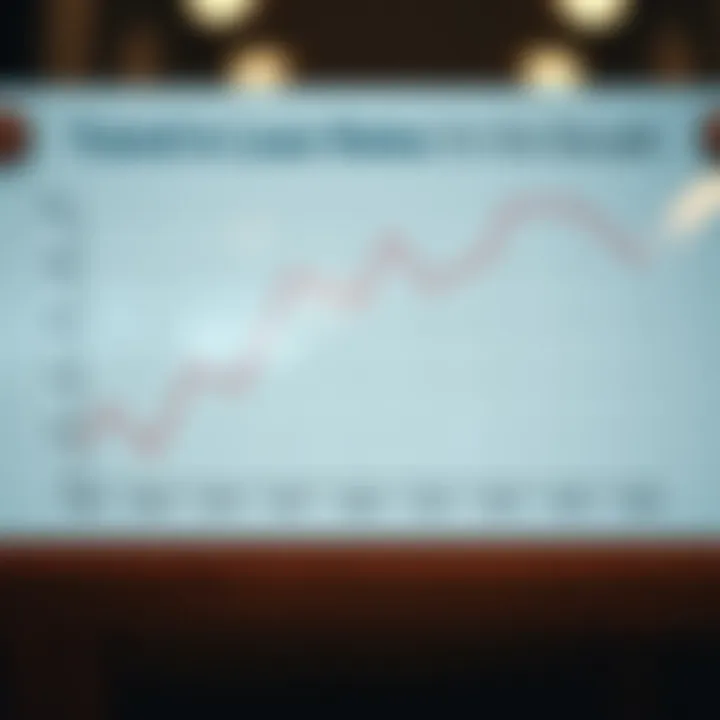Current Loan Rates: Trends and Borrower Impact Analysis


Intro
Navigating the world of loans can feel like traversing a labyrinth, especially when interest rates fluctuate like a seesaw. With borrowing costs on the rise, understanding the intricacies of current loan rates is more crucial than ever. This article aims to peel back the layers surrounding loan rates, diving into what drives these changes and how they affect various types of loans—be it a mortgage, a personal loan, or even an auto loan.
For borrowers today, shifting interest rates can create ripples across financial planning. Whether you're a first-time buyer eyeing your dream home or a seasoned investor looking to expand your portfolio, being informed about the nuances of loan rates equips you to make smarter decisions.
In this analysis, we will explore:
- The current state of loan rates
- Key financial terms and their implications
- Expert tips for both beginners and seasoned professionals
- Future predictions on loan rates
Get ready to dive deep into the world of finance, gaining a comprehensive understanding of current loan rates and their broader implications.
Understanding Loan Rates
Loan rates play a critical role in the financial ecosystem. They determine the cost of borrowing money, impacting everything from personal loans to mortgages. This section delves deep into the essence of loan rates, showcasing their importance and various dimensions in the current lending landscape. Understanding these rates is not just for lenders; it’s vital for anyone making a significant financial decision.
To start, why should everyone, from budding investors to seasoned financial enthusiasts, pay attention to loan rates? The answer is simple: loan rates affect purchasing power, savings, and overall economic health. When loan rates change, so does the affordability of loans. This influences consumer behavior, investments, and even the broader economy.
Definition of Loan Rates
Loan rates refer to the interest rate charged on loans. They can be seen as the cost of borrowing money. Typically expressed as an annual percentage, loan rates can fluctuate based on several factors, including market conditions and the borrower's creditworthiness. In short, understanding loan rates will help you grasp how much a loan will actually cost over time.
Types of Loan Rates
When it comes to loan rates, there’s no one-size-fits-all approach. Various types cater to different needs and financial situations. Here’s a closer look at the most common types:
Fixed Rate Loans
Fixed rate loans are a popular choice among borrowers looking for stability. The primary aspect of fixed rate loans is that the interest rate remains constant over the life of the loan. This characteristic grants predictability, making budgeting easier for borrowers. Whether you’re paying off a mortgage or a personal loan, knowing what your payments will be can be a huge relief.
The unique feature of fixed rate loans is their resistance to market fluctuations. For instance, if rates rise, borrowers with fixed rate loans are shielded from those increases. However, it's essential to note that these rates are generally higher than those of variable rate loans. In a nutshell, fixed loans offer security at a price.
Variable Rate Loans
Variable rate loans, also known as adjustable-rate loans, bring a different flavor to borrowing. The key characteristic of these loans is that their interest rates can change over time based on a benchmark rate. This can be appealing in a low-rate environment, as it may start with a lower initial rate compared to fixed loans.
The unique aspect of variable rate loans is the potential for lower payments initially, which can be enticing for many borrowers. However, there's a flip side. If rates rise, borrowers can face a jolt in their monthly payments, leading to budgetary challenges. In the grand tapestry of loan options, variable loans can be both an opportunity and a risk.
Introductory Rates
Introductory rates often entice borrowers with a temporary low interest rate for a set period, usually ranging from six months to a year. This feature can significantly lower initial payments, which can be attractive for those who want to minimize costs at the outset.
However, the characteristic that sets these rates apart is that they are promotional. After the introductory period ends, the rate adjusts to a much higher standard variable rate. While these rates can be a boon in the short term, borrowers must be cautious and ensure they understand what the long-term implications are. Falling into the trap of high subsequent payments can be a stark wake-up call for unwary borrowers.
Understanding loan rates means knowing what’s available to you and what suits your financial situation best. This knowledge can empower you to negotiate better terms and make informed choices that benefit your financial future.
Current Trends in Loan Rates
Understanding the current trends in loan rates is essential for anyone navigating the financial landscape today. Loan rates can significantly shift based on a variety of economic factors, and being aware of these trends can help borrowers make informed decisions. For example, observing patterns in rate movement may indicate the right time to apply for loans or refinance existing ones. Being in tune with these shifts can lead to substantial savings or larger financial burdens, depending on one’s timing and approach.
Recent Changes in Loan Rates
The changes in loan rates over the past year presented quite a mixed bag for borrowers. A number of factors have contributed to a notable increase in interest rates across various lending sectors. Federal Reserve actions aimed at controlling inflation led to a series of rate hikes. As a result, fixed mortgage rates climbed past the 6% mark, while variable rate loans saw quicker adjustments reflecting market volatility.
One might ask how exactly these recent changes affect borrowers. With borrowing costs on the rise, monthly payments have seen an uptick, signaling a shift in affordability. For example, a 1% increase on a $200,000 mortgage can add roughly $120 to monthly payments, illustrating how slight changes can have a sizable impact on household budgets.


Furthermore, consumers are adjusting to these realities. Reports indicate a significant drop in applications for home loans as buyers weigh their options against higher interest rates. This trend could affect the housing market, potentially cooling it down, as fewer people enter the fray due to financial strain.
Comparison to Previous Years
When we look back, the loan rate landscape has seen considerable evolution. For instance, in the years following the 2008 financial crisis, rates were exceptionally low—often dipping below 3%—to stimulate the economy. Fast forward to today, and these rates have positioned themselves at levels that haven’t been witnessed in over a decade.
A direct comparison illustrates this shift vividly: loans that once fetched an interest rate under 3% are now hovering above 6%. The consequences of this are profound for both new homebuyers and those looking to refinance. When examining rates from previous years, one can see how the trend is not merely about numbers, but also intertwined with broader economic conditions, including inflationary pressures that impact borrower behaviors and decisions.
"With interest rates in flux, it is pivotal that borrowers stay updated on current trends to avoid being caught off guard by changing market conditions."
In summary, current trends in loan rates reveal a landscape fraught with challenges for borrowers but also opportunities for strategic financial planning. By drawing comparisons to earlier years, one can gain context that enhances understanding and navigational strategies in today’s borrowing environment.
Factors Influencing Loan Rates
The realm of loan rates is a complex one, shaped by various elements that affect them uniquely and dramatically. Understanding the factors influencing these rates can provide valuable insight for borrowers. The way loan rates respond to certain indicators is vital for anyone looking to navigate the lending landscape efficiently. Insights in this article shed light on the interconnectedness of these elements, ultimately affecting the borrowing costs for consumers.
Economic Indicators
Economic indicators serve as the canary in the coal mine when it comes to assessing the health of the financial landscape. They are crucial in determining the trajectory of loan rates. Through various benchmarks, such as inflation, unemployment, and GDP growth, we can decipher the broader economic picture, which directly impacts lending conditions.
Inflation Rates
Inflation rates often play a pivotal role in shaping the conversation around loan rates. When inflation rises, purchasing power dwindles, prompting lenders to adjust their interest rates accordingly. This characteristic makes inflation rates a bellwether for loan costs. To put it simply, when inflation is higher than the increase in wages, it leads to a squeeze on borrowers. A unique aspect of inflation is that it varies, influenced by factors like consumer demand and supply chain constraints. This fluctuation can either bolster or weaken borrowers' positions in the market, frequently leading to a reconsideration of loan terms.
Unemployment Statistics
Unemployment statistics provide essential insights into the economic landscape as well. High unemployment might signal a cooling economy, leading to lower loan rates in an attempt to spur borrowing and spending. Conversely, low unemployment often leads to increased consumer confidence, which can prompt lenders to raise rates. A key aspect of these statistics is their lagging nature; they may not reflect current market conditions immediately. Thus, borrowers must keep an eye on these trends as they can have both immediate and sweeping effects on their financial decisions.
GDP Growth
The gross domestic product (GDP) growth rate is perhaps the most significant indicator of economic health. As the economy grows, it tends to create more jobs and increase consumer spending. This uptick can lead lenders to increase loan rates, anticipating that borrowers will be able to repay the loans through their growing incomes. An interesting feature of GDP growth is its cyclical nature, wherein periods of expansion can shift to contraction unexpectedly. Therefore, understanding the GDP trend can serve as a guiding star for borrowers looking to optimize their loan strategy.
Central Bank Policies
Central bank policies are fundamental in setting the stage for loan rates. Decisions made by institutions such as the Federal Reserve in the United States can ripple through the economy, influencing borrowing costs and consumer behavior. These policies encompass a variety of actions that directly impact loan rates.
Interest Rate Adjustments
Interest rate adjustments by central banks are among the most powerful tools that influence loan rates. When central banks raise interest rates, borrowing costs increase almost immediately across various loan types. This adjustment is largely based on inflation control, aiming to keep the economy from overheating. Key is recognizing that these adjustments work on a broader scale; an increase in rates could discourage borrowing, leading to reduced consumer spending. On the flip side, lowering rates can stimulate the economy but may pose risks of rising inflation.
Quantitative Easing
Quantitative easing refers to the practice where a central bank purchases securities to inject money into the economy, thereby increasing liquidity. This strategy can lower interest rates, making it easier for consumers to borrow. Its unique characteristic lies in the breadth of its impact; it can be employed in various economic conditions. While it often leads to lower loan rates, it also brings potential disadvantages that borrowers should be wary of, such as the risk of future inflation or asset bubbles. Monitoring these moves becomes crucial for borrowers making long-term financial decisions.
Global Market Influences
Global market influences are another critical factor affecting loan rates. As interconnectedness increases, events and trends outside one's country can have immediate implications domestically. Understanding these influences can help determine how external conditions shape domestic loan rates.
Foreign Investment Flows
Foreign investment flows can significantly influence loan rates by affecting the demand for government and corporate bonds. Higher foreign investments in a country often strengthen the currency and lower interest rates. This characteristic is crucial because it indicates that a stable economic environment can attract capital. However, fluctuations in global markets or political instability can negatively impact this flow, leading to higher loan rates if demand diminishes.
Trade Dynamics
Trade dynamics, which include the balance of imports and exports, can also sway loan rates. A favorable trade balance may lead to stronger economic growth and higher currency value. This positive outlook can push interest rates down. Yet, with increased import tariffs or trade tensions, rates may surge as economic uncertainty prevails. It's fundamental to recognize the global landscape's impact, as these dynamics can shift quickly, necessitating agility from borrowers looking for the best rates.


Understanding these factors not only provides clarity but also empowers borrowers to make informed decisions in an era where loan rates are increasingly volatile. By paying attention to economic indicators, central bank policies, and global market influences, individuals can better navigate the challenges and opportunities presented by the lending landscape.
Impact of Rising Loan Rates
The impact of rising loan rates is a crucial aspect of the current economic landscape, and understanding it can help both borrowers and investors navigate the challenges ahead. Loan rates, primarily influenced by central bank policies and market conditions, play a pivotal role in shaping financial decisions. When these rates increase, borrowers face immediate changes, and the effects ripple through the economy, affecting spending and investment patterns across various sectors.
As loan rates climb, the cost of borrowing becomes less favorable, creating conditions that can reshape financial behaviors and economic expectations. In light of this, it is essential to delve into the specific implications of rising loan rates. Below, we analyze how these increases directly affect borrowers and broader economic systems.
Effects on Borrowers
Increased Monthly Payments
One of the first and foremost impacts of rising loan rates is the increase in monthly payments that borrowers must contend with. Simply put, as rates rise, so do the costs associated with loans. This direct correlation often places financial strain on households, forcing them to re-evaluate their budgets. For many borrowers, especially those with variable rate loans, even a slight uptick in loan rates can translate into significantly higher monthly payments.
- Key Characteristic: The key feature of increased monthly payments is its immediacy; borrowers feel this impact in their next billing cycle, making it a rather urgent concern.
- Advantages and Disadvantages: While an increase in monthly payments might compel borrowers to prioritize savings or cut discretionary spending, it can also lead to challenges in meeting essential expenses. Unfortunately, this situation can escalate into default or foreclosure for those stretched beyond their limits. Therefore, while increased payments might encourage fiscal responsibility, they can simultaneously create financial stress, leading to more significant economic implications down the road.
Loan Affordability Challenges
Rising loan rates pose significant challenges in terms of loan affordability. Many borrowers find themselves in a precarious position where the cost of securing a loan no longer aligns with their financial capabilities. The ever-increasing rates mean that potential home buyers or those seeking personal loans might have to reconsider their immediate needs.
- Key Characteristic: A critical attribute of loan affordability challenges is the widening gulf between expected monthly payments and what borrowers can genuinely afford.
- Advantages and Disadvantages: On the one hand, rising rates can deter overzealous borrowing, perhaps instilling a sense of prudence among consumers. Conversely, for those who find themselves unable to afford new loans, the effect is often a decrease in homeownership rates and reduced consumer confidence in the economy. Moreover, this dampens spending power across various sectors, further complicating the economic recovery.
Broader Economic Implications
Consumer Spending
Consumer spending is a backbone of economic health, and rising loan rates can create significant headwinds for this essential component. When consumers face higher borrowing costs, their willingness or ability to spend on discretionary items typically takes a hit. This can lead to a slowdown in economic growth, as less spending means lower demand for goods and services.
- Key Characteristic: The crucial point to note about consumer spending is how sensitive it can be to changes in loan costs; even minor fluctuations can significantly sway consumer behavior.
- Advantages and Disadvantages: While reduced spending might help some consumers stabilize their finances in the short term, it can dampen growth for businesses that rely on a consistent stream of customers. The interplay of these factors often leads to a cycle where economic growth begins to falter.
Investment in Housing Market
The housing market is particularly sensitive to rising loan rates. As borrowing costs increase, potential homeowners may find it challenging to enter the market. This can lead to decreased demand for homes, which in turn, affects property values, possibly leading to a stagnation or decline in real estate investments.
- Key Characteristic: The relationship between loan rates and housing investment is often characterized by heightened volatility, with slight rate increases capable of creating noticeable shifts in demand.
- Advantages and Disadvantages: While higher rates can cool off an overheated housing market, they can also lead to fewer transactions and prolonged inventory times. For sellers, it can translate into longer waits for buyers who can finance a purchase. In contrast, a slow housing market may not only affect homeowners but also ripple through construction, real estate financing, and related industries.
Overall, understanding the multifaceted impact of rising loan rates is neither straightforward nor singular in its effects. It presents a complex tapestry of challenges that demand careful consideration from both borrowers and stakeholders in the financial ecosystem.
Future Outlook for Loan Rates
In today's financial landscape, understanding the future outlook for loan rates holds significant importance. As borrowers navigate the complexities of financing, they need to keep a watchful eye on how prevailing conditions can shape loan costs. This aspect of financial literacy is essential not just for anticipating the next steps but also for making informed decisions that can have lasting implications.
Economic forecasts can provide insights into how interest rates might trend, helping borrowers strategize effectively. A solid grasp of potential changes in loan rates elevates one's ability to respond to market fluctuations, which can impact everything from mortgage payments to personal loan decisions. Hence, this segment of the article will delve into expert predictions and different economic scenarios that might unfold.
Predictions from Financial Experts
A variety of financial analysts and economists provide their takes on where loan rates may be heading. Their insights are often predicated upon factors like inflation, employment statistics, and central bank policies. For instance, many expect that as the economy recovers from past downturns, rates may stabilize or even reduce slightly.
One vocal analyst, noted for his foresight, recently indicated that the Federal Reserve might shift its stance in response to emerging economic patterns. According to him, if inflation continues to decline, there is potential for lower rates, enabling more individuals to afford loans.
On the other hand, some experts caution against becoming overly optimistic, pointing out persistent uncertainties in the global market. It's critical to glean information from a variety of sources to form a well-rounded view.
Potential Economic Scenarios
Understanding the future of loan rates leads naturally to assessing various economic scenarios. This allows borrowers to prepare for either favorable or adverse outcomes.


Best Case
In the best-case scenario, a robust economic revival leads to a steady decrease in loan rates over time. Consumer confidence grows, unemployment falls, and businesses thrive. Notably, the low-rate environment encourages borrowing for home purchases, which in turn stimulates the housing market.
This condition often results in increased investments, both for individuals and businesses. Moreover, with lower monthly payments, families can allocate more of their budget towards savings or discretionary spending, driving economic growth. Ultimately, the encouraging features of this scenario make it a favorable one for potential borrowers, although this optimism must be tempered with caution about sustainability.
Worst Case
Conversely, the worst-case scenario might unfold if inflation spirals out of control and the central bank is left with no choice but to increase interest rates sharply. This could lead to a slowdown in borrowing and spending, constraining economic growth. High rates could make loans much less affordable, especially for first-time homebuyers and those in precarious financial situations.
In such an environment, businesses could become hesitant to invest, affecting job creation and further contracting consumer confidence. The implications of this vast economic landscape illustrate the fine balance at play, making it imperative for borrowers to keep a close watch on these developments. Recognizing the adversities anticipated in this scenario equips individuals to brace for challenges ahead, honing their financial strategies.
Strategies for Borrowers
Navigating the landscape of loan rates can feel overwhelming, especially in a climate marked by fluctuations and uncertainty. Yet, having a well-thought-out strategy can make a significant difference for borrowers seeking to secure favorable lending terms. Understanding various approaches allows borrowers to make informed decisions without falling into common pitfalls. This section delves into essential strategies, focusing on timing, consolidation options, and the choice between fixed and variable rates—all critical elements a borrower must consider.
Timing the Market
Timing can be everything when it comes to borrowing. Economic conditions such as interest rate adjustments often fluctuate, influenced by central bank policies or broader global economic indicators. Finding the right time to secure a loan can lead to substantial savings or higher costs.
Some borrowers adopt the belief that they can outsmart the market by waiting for the perfect moment. This strategy, while enticing, often blends optimism with chance. It requires not only understanding current rates but also forecasting economic trends. A more balanced approach is to stay informed about market trends through reputable financial news outlets or resources such as Bloomberg and Investopedia.
Utilizing tools such as interest rate trackers can help borrowers gauge the market effectively. By subscribing to alerts from lenders or financial institutions, borrowers can stay updated without constantly monitoring the rates themselves. Ultimately, though, it’s more about timing in relation to personal circumstances than hitting the exact market low.
Consolidation and Refinancing Options
Loan consolidation and refinancing can be lifesavers for borrowers facing high interest rates. These strategies can reduce monthly payments or aggregate multiple loans into one manageable payment without risking additional costs. For those holding multiple loans, it presents an opportunity to simplify finances.
Refinancing involves securing a new loan to replace an old one, typically at a lower interest rate, or extending the loan term. This can decrease monthly payments substantially. Consider the experience of a borrower who previously held a mortgage at a 6% interest rate but, after refinancing, managed to secure a new mortgage at 4%. The savings can be significant over the life of the loan.
On the flip side, consolidation combines several debts into one. Borrowers must be cautious here, as extending the loan term can increase overall interest paid. It’s vital to consider if the consolidation might help in managing cash flow while ensuring that it remains financially sound. Tools like NerdWallet can provide insights and comparison across various lenders when looking into consolidation or refinancing options.
Utilizing Fixed Rates Versus Variable Rates
When deciding between fixed and variable loan rates, borrowers need to weigh their options carefully. Fixed-rate loans offer stability and predictability in payments, protecting borrowers from potential increases in rates over time. This is particularly relevant in periods where interest rates are rising or when a borrower plans to stay in their home for the long term.
Conversely, variable-rate loans may start off with lower initial rates but can escalate depending on market fluctuations. They can work well for those borrowers who plan to sell or refinance before rates increase significantly. An informed decision here hinges on understanding one's capacity to manage potential rate hikes and the degree of risk they are willing to take.
"The best loan for one borrower might not be suitable for another. Understanding personal financial situations is key in making this choice."
Ultimately, an informed decision combines market knowledge with personal financial assessment. Borrowers should not hesitate to leverage a financial advisor or trusted resources like FHA.gov to better understand their options.
End
Understanding the landscape of current loan rates is essential for both new and seasoned investors. This article has navigated through the nuances of loan rates, connecting the dots between various factors that steer their fluctuations. It is crucial for readers to grasp how the interconnected web of economic indicators, central bank actions, and global market trends shape the rates they encounter. This knowledge not only aids in making informed decisions but also equips individuals to better navigate potential challenges ahead.
Summary of Key Points
- Definitions and Types: Loan rates can be fixed, variable, or introductory, each with distinct implications for borrowers.
- Current Trends: This section provided a snapshot of recent fluctuations in loan rates and how they stack up against trends from previous years.
- Influences on Rates: A variety of factors, including inflation and central bank policies, play pivotal roles in determining loan rates.
- Impact on Borrowers: Rising rates can lead to heavier monthly payments and challenges in affordability, affecting consumer behavior and the housing market.
- Future Projections: Financial experts’ insights offered a glimpse into potential scenarios, helping readers anticipate changes in the lending landscape.
Final Thoughts and Recommendations
In closing, the implications of current loan rates cannot be understated. Borrowers must weigh their options carefully. Whether considering a mortgage or a personal loan, understanding when to lock in rates or refinance could save significant amounts over time.
Here are some recommendations:
- Stay Informed: Regularly update your knowledge on economic indicators and their effects on loan rates by following publications from credible sources like The Wall Street Journal or Investopedia.
- Consult Professionals: Speaking to financial advisors can provide tailored insights based on your unique situation, helping to make strategic decisions.
- Evaluate Financial Health: Before making borrowing decisions, assess your current financial situation to measure your capacity to handle changing repayment terms.
Ultimately, knowledge is power in today’s economic climate. By remaining vigilant and informed, borrowers can navigate the complex waters of loan rates, lending themselves the potential for savings and financial well-being.
"An informed decision today may lead to substantial savings tomorrow."
For additional resources, consider visiting Consumer Financial Protection Bureau for financial advice and tools aimed at consumers.







